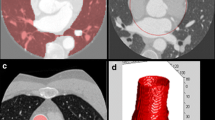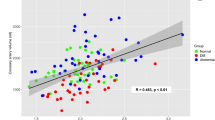Abstract
In order to review the morphological criterion for an interventional procedure, diameter stenosis (%DS) of 226 coronary lesions in 200 patients undergoing elective coronary angiography with an option for ‘prima vista’ angioplasty (pPTCA), was assessed on-site by both visual ‘eye balling’ (EB) and independent digital quantitative coronary angiography (DQCA) by means of an angiographic workstation. Compared to DQCA, EB overestimated the %DS between 50 and 80% and accounted for the majority of discrepancies with overestimation up to 45%. Concordant estimates of %DS by both methods were observed in only 10 of the total of 226 stenotic segments; in 20 of 226 cases, EB underestimated %DS up to 20%. EB revealed a %DS ≥ 60% in 166 stenoses (73.4%), an estimate that led to subsequent pPTCA. However, only 119 (52.6%) of these lesions had a %DS ≥ 60% as assessed objectively by DQCA. With regard to the criterion for PTCA 47 of 166 performed pPTCA (28.3%) would not meet the indication criteria based on objective DQCA information. EB and DQCA (± 5%DS) had concordant results and criteria for pPTCA only in 103 of 166 coronary lesions (62.1%). These results lead to the conclusion that, on-site and on-line DQCA by an independent cardiologist eliminates both under- and overestimation of stenoses as seen with EB. DQCA supports immediate decision-making and appears necessary for reliable evaluation of coronary morphology in an interventional catheterization laboratory setting and may eventually ensure intraprocedural quality control.
Similar content being viewed by others
References
Ryan TJ, Bauman WB, Kennedy JW, Kereikes DJ, King SB III, McCallister BD, Smith SC, Ullyot DJ. Guidelines for percutaneous transluminal coronary angioplasty. Circulation 1993; 88: 2987–3007.
Topol EJ, Ellis SG, Cosgrove DM, Bates ER, Muller DWM, Schork NJ, et al. Analysis of coronary angioplasty practice in the United States with an insurance-claims data base. Circulation 1993; 87: 1489–1497.
Feldmann RL, Macdonald JA, Hill R, Conti R Pepine CJ, Carmichael MJ, Knauff DG, Alexander JA. Coronary angioplasty at the time of initial cardiac catheterization. Catheter Cardiovasc Diagn 1986; 12: 219–222.
O'Keefe JH, Rutherford BD, McConahay DR, Johnson WL, Giorgi LV, Shimshak TM, et al. Myocardial salvage with direct coronary angioplasty for acute infarction. Am Heart J 1992; 123: 1–6.
Seydoux C, Goy J-J, Beuret P, Stauffer J-C, Vogt P, Schaller M-D, et al. Effectiveness of percutaneous transluminal coronary angioplasty in cardiogenic shock during acute myocardial infarction. Am J Cardiol 1992; 69: 968–969.
Vermeer F, Simoons L, de Feyter PJ, Bär FW, Suryapranata H, Fioretti P, et al. Immediate PTCA after successful thrombolysis with intracoronary streptokinasis, three years follow-up. Europ Heart J 1988; 9: 346–353.
Lund GK, Nienaber CA, Hamm CW, Terres W, Kuck K-H. One- session cardiac catheterization and balloon dilatation (‘prima vista’-PTCA): results and risks. Dtsch med Wschr 1994; 119: 169–174.
Relman AS. ‘Self-referral’ — what's at stake? New Engl J Med 1992; 327: 1522–1524.
Hilborne LH, Leape LL, Bernstein SJ, Park RE, Fiske ME, Kamberg CJ, Roth CP, Brook RH. The appropriateness of use of percutaneus transluminal coronary angioplasty in New York State. JAMA 1993; 269: 761–765.
Zir LM, Miller SW, Dinsmore RE, Gilbert JP, Harthorne JW. Interobserver variability in coronary angiography. Circulation 1975; 53: 627–632.
Marcus ML, Skorton DJ, Johnson MR, Collins SM, Harrison DG, Kerber RE. Visual estimates of percent diameter coronary stenosis: ‘a battered gold standard’ (editorial). J Am Coll Cardiol 1988; 11: 882–885.
Beauman GJ, Vogel RA. Accuracy of individual and panel visual interpretations of coronary arteriograms: implications for clinical decisions. J Am Coll Cardiol 1990; 16: 108–113.
Goldberg RK, Kleiman NS, Timor ST, Abukhalil J, Raizner AE. Comparison of quantitative coronary arteriography to visual estimates of lesion severity pre and post PTCA. Am heart J 1990; 119: 178–182.
Fleming R, Kirkkeeide RL, Smalling R, Gould KL. Patterns in visual interpretation of coronary arteriograms as detected by quantitative coronary arteriography. J Am Coll Cardiol 1991; 18: 945–951.
Bertrand ME, Lablanche JM, Bauters C, Leroy F, Fadden EM. Discordant results of visual and quantitative estimates of stenosis severity before and after coronary angioplasty: Cathet Cardiovasc Diagn 1993; 28: 1–6.
Desmet W, Willems J, Van Lierde J, Piessens J. Discrepancy between visual estimation and computer-assisted measurement of lesion severity before and after coronary angioplasty. Catheter Cardiovasc Diagn 1994; 31 (3): 192–198.
Moertl D, Binder T, Gottsauner-Wolf M, Sochor H, Probst P, Porenta G. Assessment of coronary artery stenoses: comparison of quantitative coronary angiography with visual interpretation and myocardial scintigraphy. In: Computers in Cardiology, Vienna 1995. Los Alamitos CA: IEEE Computer Society Press, 1995: 145–148.
Ischinger T, Gruentzig AR, Hollman J, King S III, Douglas J, Meier B, Bradford J, Tankersley R. Should coronary arteries with less than 60% diameter stenosis be treated by angioplasty? Circulation 1983; 68: 148–154.
Ross J Jr, Brandenburg RO, Dinsmore RE and the American College of Cardiology/American Heart Association Task Force Report. Guidelines for coronary angiography. Circulation 1987; 76: 963A-977A.
Stiel GM, Stiel LSG, Barth K, Nienaber CA. Patient Defined Digital Angiocardiography (PDDA): a valid way for Individual Staging of Coronary Artery Disease. In: Brody WR, Johnston GS (eds) Computer Applications to Assist Radiology. Symposia Foundation, Carlsbad, MD, 1992; 712–713.
Stiel GM, Barth K, Eicker B, Vogel C, Towara U, Nienaber CA. AWOS™: angiographic workstation for digital quantitative coronary angiography. In: Computers in Cardiology, London 1993, Los Alamitos CA: IEEE Computer Society Press, 1994: 599–602.
Stiel GM, Nienaber CA, Lattermann A, Barth K, Meinertz T. Comparison of coronary vessels edge detection and cross line methods to quantify the degree of stenosis as accessed by digital systems. In: Computers in Cardiology, Bethesda 1994. Los Alamitos CA: IEEE Computer Society Press, 1995: 473–475.
Fleiss, JL. Statistical methods for rates and proportions. 2nd ed. New York: Wiley, 1981: pp. 432.
King SB III, Weintraub WS, Tao X, Hearn J, Douglas JS Jr. Bimodal distribution of diameter stenosis 4 to 12 month after angioplasty: implications for definitions and interpretation of restenosis (abstr). J Am Coll Cardiol 1991; 17: 345A.
Rensing BJ, Hermans WRM, Deckers JW, Feyter PJ de, Tijssen JGP, Serruys PW. Lumen narrowing after percutaneous transluminal coronary ballon angioplasty follows a near gaussian distribution: a quantitative angiographic study in 1,445 successfully dilated lesions. J Am Coll Cardiol 1992; 19: 939–45.
Topol EJ. Quality of care in interventional cardiology. In: Topol EJ, ed. Textbook of interventional cardiology. Philadelphia: Saunders, 1994: 1354–1367.
Ryan TJ, Klocke FJ, Reynolds WA and ACP/ACC/AHA Task Force Members. Clinical competence in percutaneous transluminal coronary angioplasty. J Am Coll Cardiol 1990; 5: 1469–1474.
Spittell JA Jr, Creager MA, Dorros G, Isner JM, Nanda NC, Ochsner JL, Wexler L, Young JR and ACC Peripheral Vascular Disease Committee. Recommendations for training in vascular Medicine. J Am Coll Cardiol 1993; 2: 626–628.
Douglas JS Jr, Pepine CJ, Block PC, Brinker JA, Johnson WL Jr, Klinke WP and ACC Cardiac Catheterization Committee. Recommendations for Development and Maintenance of Competence in Coronary Interventional Procedures. J Am Coll Cardiol 1993; 2: 629–631.
Author information
Authors and Affiliations
Rights and permissions
About this article
Cite this article
Stiel, G.M., Schaps, KP., Lattermann, A. et al. On-site digital quantitative coronary angiography: comparison with visual readings in interventional procedures. Int J Cardiac Imag 12, 263–269 (1996). https://doi.org/10.1007/BF01797740
Accepted:
Issue Date:
DOI: https://doi.org/10.1007/BF01797740




